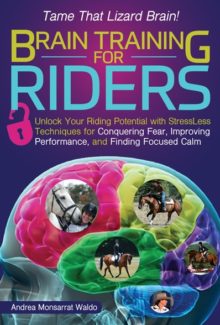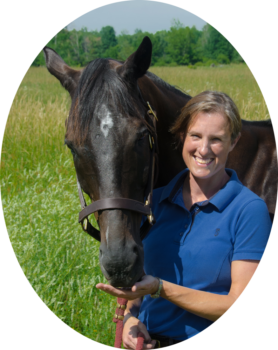“You should just sell your horse and quit riding. You’re never going to get any better so you might as well just give up.”
“Everyone else here is better than you. You have no business being here. Everyone is laughing at you.”
“You’re worse than a worm. You’re the worm at the bottom of the manure pile.”
The above statements sound like the script for Mean Girls Go to the Horse Show. But these weren’t said by one teenaged girl to another. These are actual quotes that some of my clients say to themselves, both inside their heads and out loud. (And I did not make that last one up.) Of all the harmful thinking habits I know, Negative Self Talk (NST) is the most destructive. It cuts people off at the knees before they can even get started, and it can sabotage even the biggest success.
Most people know intuitively that if you tell a small child something often enough, they will eventually believe it. People often become upset when someone criticizes a child constantly, because they know that eventually she will believe that she is worthless or incompetent. The same thing happens to adults, though, when they criticize themselves relentlessly. And what you believe about yourself directly affects how you behave. If you tell yourself “I’m a terrible rider,” you are likely to approach a jump less confidently than if you think “I know how to do this.” That less confident approach may lead to a poor jump, leading to even more criticism. “See, I am a terrible rider!” This is a classic self-fulfilling prophecy. If you see yourself as the worm at the bottom of the manure pile, you will probably experience shame. Shame is the most paralyzing emotion there is: it makes you want to crawl under a rock and hide. This makes you less likely to get out there and get your seat in the saddle, which makes you feel more like a worm…and you’re stuck in a miserable NST feedback loop instead of enjoying your riding.
Another NST trap has to do with your attributions, or who and what gets credit for your successes and failures. NST convinces people to attribute their successes to something external (luck, the mood of their horse), and their failures to internal factors (lack of talent, poor work ethic, general worminess). It blocks out any evidence to the contrary and interprets every event through the lenses of these attributions. Here’s how it works:
Our barn has an arena with a fabric roof, and when snow slides off of the roof it sounds like a giant zipper. “Monica” was having a lesson and her mare did not appreciate the sound. Every time the snow slid, the mare leapt and twisted and bucked in an outstanding imitation of a rodeo bronc. Monica sat tight and stayed in the saddle the whole time. When I congratulated her on this, she replied “It was an act of God that I didn’t get bucked off!” I burst out laughing and said that with all due respect, I didn’t think God had much to do with it, and asked her what she had done to stay on. It took some hard thinking before she identified factors such as sitting tall and wrapping her legs around her horse. Once she did, though, this gave her a boost of confidence. She changed her NST to the more realistic “I’ve developed a good seat and leg so I can stay in the saddle when my horse acts up.” Remembering this incident later as a result of her own skill rather than divine intervention, she felt more confident to try new things such as going trail riding by herself.
A negative attribution style also views mistakes or problems as global and permanent, and successes or strengths as specific and temporary. Thus, chipping in at a fence means “I stink at jumping,” but a fence well jumped is dismissed as “well, at least I got one right.” This NST creates a no-win situation. If mistakes mean “I stink,” then you’ll always stink because mistakes are inevitable! If success only counts for that moment, you’ll never develop confidence and trust in your abilities, because in the next moment you could make a mistake and then your NST will say “See? Told you that you stink.”
So how do we escape this loop of NST and terrible feelings? The first step is what our moms told us when we were mean to someone: watch your language and be polite! You wouldn’t talk to your friends this way, so why are you being so mean and nasty to yourself? Any time you hear your NST say something mean, remind it to be polite. For example, change “You’ll never get this right” to “You’re really having trouble with this right now, but you can get it if you stick with it.” Or if it refuses to be polite, take Thumper’s advice in Bambi: “If ya can’t say somethin’ nice, don’t say nothin’ at all.” One of my students just says “ssh” when her NST starts nattering at her.
Once you’re being more polite to yourself, it’s time to change NST to PST—Positive Self Talk. Many people groan when I bring this up. “I’ve tried this positive affirmation stuff and it doesn’t work. Telling myself ‘I’m a great rider’ just feels fake.” Actually, I agree with this wholeheartedly. “Affirmations” usually fail because they are vague and have no evidence in the real world to support them. PST, on the other hand, is based on evidence and is realistic. Here is one example:
Michelle crosses the finish line of the cross country course with a scowl on her face. “It was terrible. We stopped at the water because I didn’t have enough leg on. I’m such an idiot.”
Terry, on the other hand, finishes with a smile. “I’m bummed because I forgot to put my leg on at the water and he stopped. We got through it on the second try though, and the rest of the course was awesome!”
Both riders had the same problem, but Michelle returns to the barn feeling discouraged while Terry feels happy and confident. Terry’s PST is not fake or unrealistic; she acknowledges the problem that needs work but also the many positives that occurred. She takes responsibility for the successes and the failures, not just the failures. She feels more confident and has a more realistic view of her abilities as a result.
Be aware of your attributions and change them when NST creeps in. If you jump a fence well, note what you did right. “I’m really getting better at finding a distance.” When you make a mistake, describe the problem in specific rather than global terms: “I missed that time. I need to ride more forward.” Notice the whole picture, not just the problem: “I bobbled my canter transition, but the circle afterward was better.”
Do you have difficulty keeping positive events in your mind? Write them down. After every ride, note down at least three things that you did well—not perfectly, just well! If you hate journals, text it to yourself or use a smartphone app to keep the list. Glance at it occasionally so that, in Monica’s words, “I have some proof that I don’t stink.”
PST is not an attempt to turn yourself into Susie Sunshine or to ignore problems when they occur. Instead, it helps you to have a realistically positive outlook and builds confidence in your strengths and ability to solve problems, which in turn leads to better riding—and more enjoyment in the whole experience.



